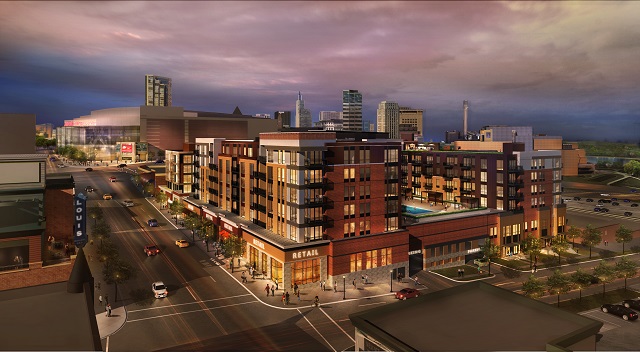 MINNEAPOLIS—Like many US cities, downtown Minneapolis has undergone a renaissance that has transformed the surrounding neighborhoods from warehouse districts into luxury apartment communities. In some areas, such as the North Loop, that change is nearly complete, and may even be moving into a new phase. “This is a residential community that continues to grow, but it largely has made the change,” Matt Rauenhorst , vice president, real estate development, Opus Development Co., LLC , tells GlobeSt.com. “The limit on this cycle is availability of sites rather than demand.” And office developers are now moving in, and see many opportunities to establish workplaces in the now-lively neighborhood. “That seems to be the next step in its evolution.” But the Twin Cities still provides a lot of prospects for multifamily developers, as the neighboring St. Paul market is seeing a migration of renters into its downtown area, and its change is at a much earlier stage. As reported in GlobeSt.com, Minneapolis-based Opus has been one of the most active developers in the Twin Cities region, and has projects underway in both major cities and the suburbs. In 2014, the company completed The Nic on Fifth, a 26-story luxury high-rise apartment complex, the first of its kind in Minneapolis' downtown core in nearly three decades. Before that, it finished VÉLO , a luxury apartment building in the North Loop area. And Opus just started construction on a six-story, U-shaped apartment and retail development on W. Seventh St. in downtown St. Paul that will feature 191 units. Developers have added more than 13,000 multifamily units to the Twin Cities region since 2013, according to a report published late last year by Minneapolis-based NAI Everest . Vacancy rates in the Twin Cities averaged just 2.3%, the researchers found. The non-downtown St. Paul submarket had, at 1.4%, the lowest rate in the region. Downtown Minneapolis vacancy rates averaged 6.4% and downtown St. Paul rates averaged 2.8%. Rauenhorst says that St. Paul is following a slightly different path than its counterpart. Rehab jobs of existing buildings have been more important than in Minneapolis, which had more new construction. Furthermore, “St. Paul has far fewer office jobs; it's a smaller community.” Still, “it's not a bedroom community of Minneapolis; it stands on its own.” And the future still looks bright for the region's multifamily developers. Investors now consider the Twin Cities a top ten market, perhaps even one in the top five, Rauenhorst says. The average price per unit in the Twin Cities hit $132,405 in 2015, a 29% increase from the previous year, according to NAI Everest. Rauenhorst attributes this to the incredibly robust economy, which regularly records the one of the nation's lowest unemployment rates for large metro areas. “That is the strength of this community.”
MINNEAPOLIS—Like many US cities, downtown Minneapolis has undergone a renaissance that has transformed the surrounding neighborhoods from warehouse districts into luxury apartment communities. In some areas, such as the North Loop, that change is nearly complete, and may even be moving into a new phase. “This is a residential community that continues to grow, but it largely has made the change,” Matt Rauenhorst , vice president, real estate development, Opus Development Co., LLC , tells GlobeSt.com. “The limit on this cycle is availability of sites rather than demand.” And office developers are now moving in, and see many opportunities to establish workplaces in the now-lively neighborhood. “That seems to be the next step in its evolution.” But the Twin Cities still provides a lot of prospects for multifamily developers, as the neighboring St. Paul market is seeing a migration of renters into its downtown area, and its change is at a much earlier stage. As reported in GlobeSt.com, Minneapolis-based Opus has been one of the most active developers in the Twin Cities region, and has projects underway in both major cities and the suburbs. In 2014, the company completed The Nic on Fifth, a 26-story luxury high-rise apartment complex, the first of its kind in Minneapolis' downtown core in nearly three decades. Before that, it finished VÉLO , a luxury apartment building in the North Loop area. And Opus just started construction on a six-story, U-shaped apartment and retail development on W. Seventh St. in downtown St. Paul that will feature 191 units. Developers have added more than 13,000 multifamily units to the Twin Cities region since 2013, according to a report published late last year by Minneapolis-based NAI Everest . Vacancy rates in the Twin Cities averaged just 2.3%, the researchers found. The non-downtown St. Paul submarket had, at 1.4%, the lowest rate in the region. Downtown Minneapolis vacancy rates averaged 6.4% and downtown St. Paul rates averaged 2.8%. Rauenhorst says that St. Paul is following a slightly different path than its counterpart. Rehab jobs of existing buildings have been more important than in Minneapolis, which had more new construction. Furthermore, “St. Paul has far fewer office jobs; it's a smaller community.” Still, “it's not a bedroom community of Minneapolis; it stands on its own.” And the future still looks bright for the region's multifamily developers. Investors now consider the Twin Cities a top ten market, perhaps even one in the top five, Rauenhorst says. The average price per unit in the Twin Cities hit $132,405 in 2015, a 29% increase from the previous year, according to NAI Everest. Rauenhorst attributes this to the incredibly robust economy, which regularly records the one of the nation's lowest unemployment rates for large metro areas. “That is the strength of this community.”  MINNEAPOLIS—Like many US cities, downtown Minneapolis has undergone a renaissance that has transformed the surrounding neighborhoods from warehouse districts into luxury apartment communities. In some areas, such as the North Loop, that change is nearly complete, and may even be moving into a new phase. “This is a residential community that continues to grow, but it largely has made the change,” Matt Rauenhorst , vice president, real estate development, Opus Development Co., LLC , tells GlobeSt.com. “The limit on this cycle is availability of sites rather than demand.” And office developers are now moving in, and see many opportunities to establish workplaces in the now-lively neighborhood. “That seems to be the next step in its evolution.” But the Twin Cities still provides a lot of prospects for multifamily developers, as the neighboring St. Paul market is seeing a migration of renters into its downtown area, and its change is at a much earlier stage. As reported in GlobeSt.com, Minneapolis-based Opus has been one of the most active developers in the Twin Cities region, and has projects underway in both major cities and the suburbs. In 2014, the company completed The Nic on Fifth, a 26-story luxury high-rise apartment complex, the first of its kind in Minneapolis' downtown core in nearly three decades. Before that, it finished VÉLO , a luxury apartment building in the North Loop area. And Opus just started construction on a six-story, U-shaped apartment and retail development on W. Seventh St. in downtown St. Paul that will feature 191 units. Developers have added more than 13,000 multifamily units to the Twin Cities region since 2013, according to a report published late last year by Minneapolis-based NAI Everest . Vacancy rates in the Twin Cities averaged just 2.3%, the researchers found. The non-downtown St. Paul submarket had, at 1.4%, the lowest rate in the region. Downtown Minneapolis vacancy rates averaged 6.4% and downtown St. Paul rates averaged 2.8%. Rauenhorst says that St. Paul is following a slightly different path than its counterpart. Rehab jobs of existing buildings have been more important than in Minneapolis, which had more new construction. Furthermore, “St. Paul has far fewer office jobs; it's a smaller community.” Still, “it's not a bedroom community of Minneapolis; it stands on its own.” And the future still looks bright for the region's multifamily developers. Investors now consider the Twin Cities a top ten market, perhaps even one in the top five, Rauenhorst says. The average price per unit in the Twin Cities hit $132,405 in 2015, a 29% increase from the previous year, according to NAI Everest. Rauenhorst attributes this to the incredibly robust economy, which regularly records the one of the nation's lowest unemployment rates for large metro areas. “That is the strength of this community.”
MINNEAPOLIS—Like many US cities, downtown Minneapolis has undergone a renaissance that has transformed the surrounding neighborhoods from warehouse districts into luxury apartment communities. In some areas, such as the North Loop, that change is nearly complete, and may even be moving into a new phase. “This is a residential community that continues to grow, but it largely has made the change,” Matt Rauenhorst , vice president, real estate development, Opus Development Co., LLC , tells GlobeSt.com. “The limit on this cycle is availability of sites rather than demand.” And office developers are now moving in, and see many opportunities to establish workplaces in the now-lively neighborhood. “That seems to be the next step in its evolution.” But the Twin Cities still provides a lot of prospects for multifamily developers, as the neighboring St. Paul market is seeing a migration of renters into its downtown area, and its change is at a much earlier stage. As reported in GlobeSt.com, Minneapolis-based Opus has been one of the most active developers in the Twin Cities region, and has projects underway in both major cities and the suburbs. In 2014, the company completed The Nic on Fifth, a 26-story luxury high-rise apartment complex, the first of its kind in Minneapolis' downtown core in nearly three decades. Before that, it finished VÉLO , a luxury apartment building in the North Loop area. And Opus just started construction on a six-story, U-shaped apartment and retail development on W. Seventh St. in downtown St. Paul that will feature 191 units. Developers have added more than 13,000 multifamily units to the Twin Cities region since 2013, according to a report published late last year by Minneapolis-based NAI Everest . Vacancy rates in the Twin Cities averaged just 2.3%, the researchers found. The non-downtown St. Paul submarket had, at 1.4%, the lowest rate in the region. Downtown Minneapolis vacancy rates averaged 6.4% and downtown St. Paul rates averaged 2.8%. Rauenhorst says that St. Paul is following a slightly different path than its counterpart. Rehab jobs of existing buildings have been more important than in Minneapolis, which had more new construction. Furthermore, “St. Paul has far fewer office jobs; it's a smaller community.” Still, “it's not a bedroom community of Minneapolis; it stands on its own.” And the future still looks bright for the region's multifamily developers. Investors now consider the Twin Cities a top ten market, perhaps even one in the top five, Rauenhorst says. The average price per unit in the Twin Cities hit $132,405 in 2015, a 29% increase from the previous year, according to NAI Everest. Rauenhorst attributes this to the incredibly robust economy, which regularly records the one of the nation's lowest unemployment rates for large metro areas. “That is the strength of this community.”Want to continue reading?
Become a Free ALM Digital Reader.
Once you are an ALM Digital Member, you’ll receive:
- Breaking commercial real estate news and analysis, on-site and via our newsletters and custom alerts
- Educational webcasts, white papers, and ebooks from industry thought leaders
- Critical coverage of the property casualty insurance and financial advisory markets on our other ALM sites, PropertyCasualty360 and ThinkAdvisor
Already have an account? Sign In Now
*May exclude premium content© 2025 ALM Global, LLC, All Rights Reserved. Request academic re-use from www.copyright.com. All other uses, submit a request to [email protected]. For more information visit Asset & Logo Licensing.








